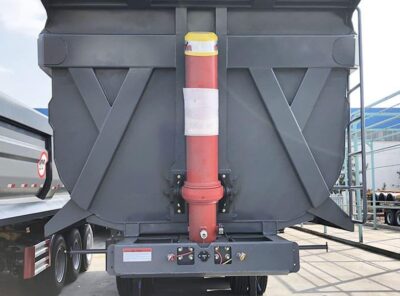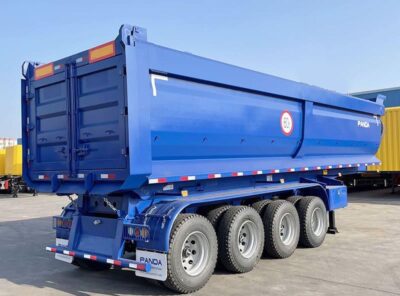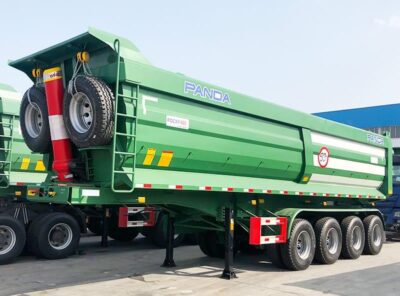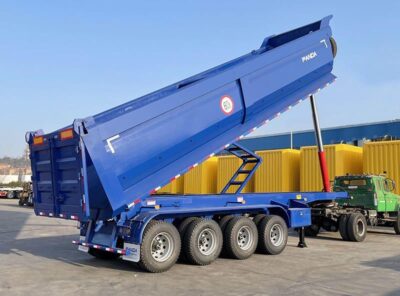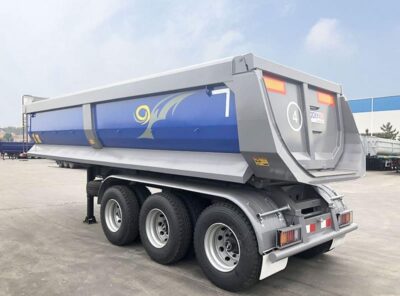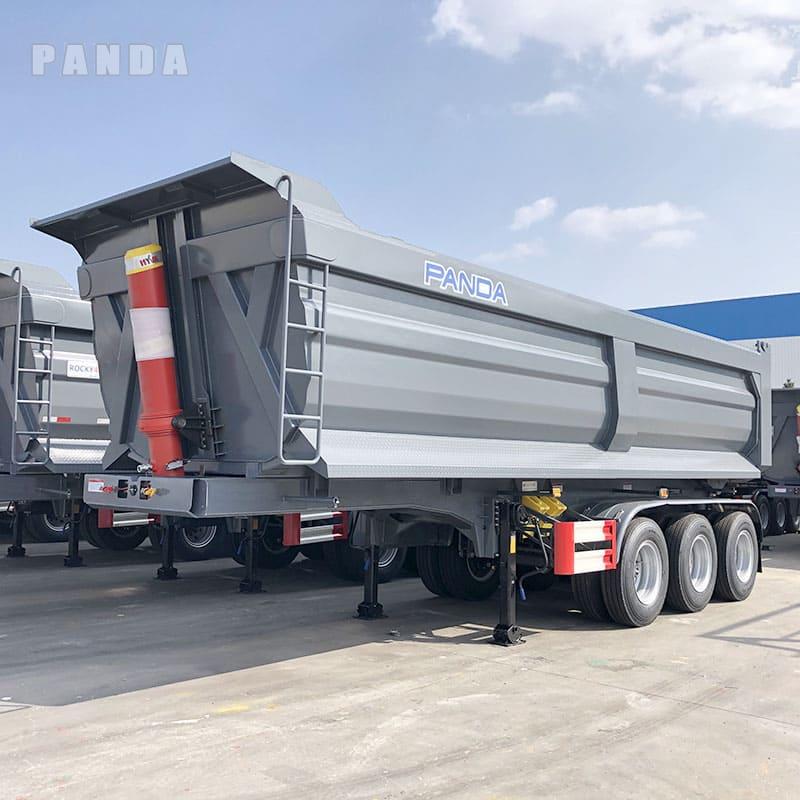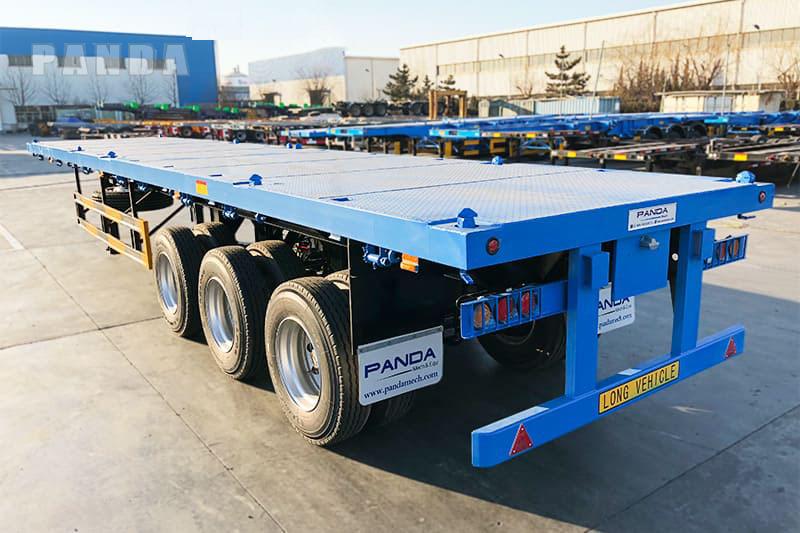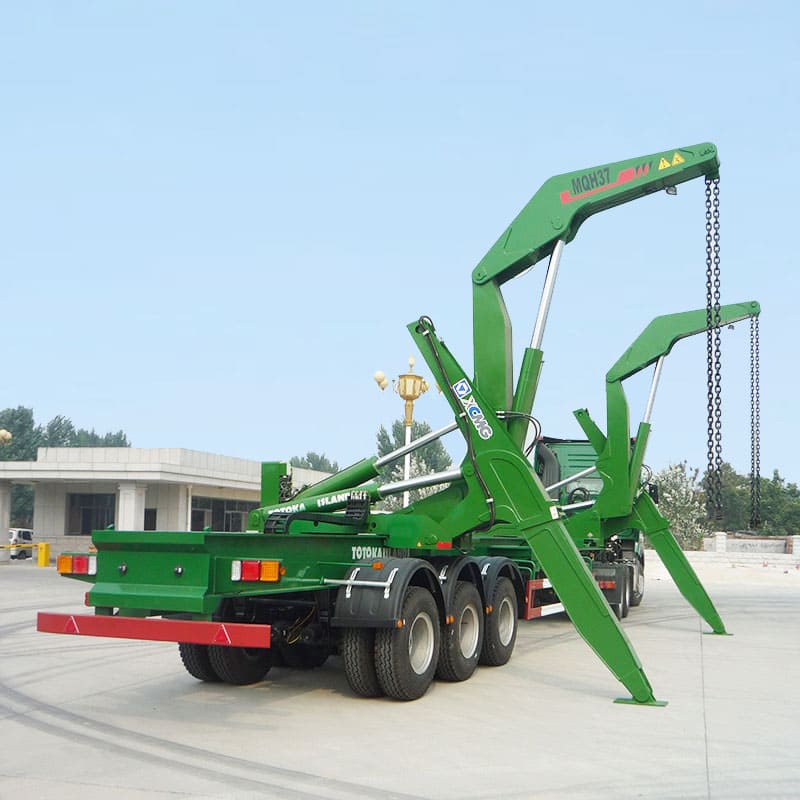Friends, I meet you again. I am Zac. Recently, a customer asked about the various parts of a semi-tipper trailer in detail when purchasing one. Because he just joined the industry, he didn’t know anything about the various parts of a semi-tipper. Today, I wrote an article to give a comprehensive explanation, and I hope it can help you. If you have a friend who has the same problem, I hope you can share this article with him.

Main parts of a semi tipper trailer
The main parts include:
- Hydraulic Cylinder
- Chassis Frame
- Tipping Body
- Suspension System
- Axles
- Tyres
- Brake System
- Tailgate
- King Pin & Landing Gear
We will mainly talk about several parts: purpose, working principle, composition, maintenance, and the differences between each part;
Hydraulic Cylinder
One of the most important parts in my tipper semi trailer is the hydraulic cylinder. Let me tell you why it matters so much.

1. What It’s Used For
The hydraulic cylinder helps me lift the trailer bed. That way, I can dump heavy stuff like coal, rocks, or sand. I just press a button, and it lifts the whole back of the trailer. It saves me a lot of time and hard work.
2. How It Works
It works with hydraulic oil and pressure. When I use the controls, oil pushes a metal rod out. That rod lifts the trailer up. When I want to put the trailer back down, the oil goes the other way. It’s smooth and safe.
3. How Much It Can Lift
My trailer’s cylinder can lift 20 to 60 tons. That’s like lifting 10 or more cars at once! Some stronger cylinders can lift 70 tons or more. That’s great when I carry really heavy loads
4. Brands I Trust
I’ve used a few different brands. Here are the ones I like:
- Hyva – very strong and reliable
- Binotto – smooth and easy to use
- Edbro – great for big trailers
- Parker – works well in many kinds of trucks
They all make good-quality cylinders that last a long time.
5. What It’s Made Of
A cylinder has a few main parts:
- A strong metal barrel
- A piston rod that moves in and out
- Seals to keep oil inside
- Some caps and rings to guide it
Most cylinders I use are telescopic, which means they come out in sections. This helps them lift high but stay short when closed.
6. Can I Change the Seals?
Yes, I can! If the cylinder starts leaking oil, I just change the seal kit. Most brands sell the kits I need. It’s cheaper than buying a new cylinder. This keeps my tipper semi trailer working well.
Chassis Frame
Chassis Frame is like the bones of the trailer. If the frame isn’t strong, nothing else matters.
What It’s Made Of
- Q345 steel – strong, flexible, and good for most jobs
- Q700 steel – even stronger, great for heavy-duty loads
- Both types are high-strength steel
- They last long and don’t break easily

2. How It’s Reinforced
To keep the frame strong, we use double I-beams (like the letter “I”) and triangle supports. The I-beams help the trailer stay straight and balanced. The triangle parts give extra support under the body, especially when lifting heavy stuff. These shapes are simple, but they work really well.
3. How Much Can It Hold?
40 to 80 tons.
With these strong materials and smart design, the chassis frame can carry a lot of weight. Most of my trailers can handle 40 to 80 tons without a problem. Some heavy-duty ones can take even more. I never worry about the frame bending or cracking — it’s built for hard work.
Tipping Body
The tipping body is used to carry cargo. According to the different goods transported, the thickness of the box is also different.
1. Volume (Cubic Meters)
20-60 CBM, 25 – 80 Ton.

2. Thickness
The steel is thick where it matters. The bottom plate is usually 6 to 10 mm, because it takes the most hits when I load heavy stuff. The side walls are about 4 to 6 mm thick. This helps the body stay strong and not get dented or worn out too fast.
3. Steel Material
For the best strength, I use Hardox steel or other wear-resistant steel from trusted brands. Hardox is really tough and lasts a long time, even when I carry sharp or heavy rocks. It may cost more, but it saves money in the long run because I don’t have to repair it as much.
Suspension of semi tipper trailer

Suspension is super important for my trailer. It helps handle bumps, carry heavy loads, and keep the trailer safe on rough roads.
1. How Many Leaf Springs?
Most of my trailers use mechanical suspension with 7 to 13 leaf springs per axle. These are thick steel plates stacked together. The more plates there are, the stronger the suspension. It’s perfect for carrying heavy loads over long distances.
2. Is Air Suspension Optional?
Yes, air suspension is also available. It uses air bags instead of metal springs. I like it because it gives a smoother ride and helps protect the trailer and cargo. But it’s better for highway use. In very rough areas, I still prefer steel leaf springs.
3. Is It Good for Mining Areas?
Yes – if I use multi-leaf mechanical suspension, it works great in mining zones. These places are rough, dusty, and full of big rocks. Leaf spring suspension is tough, doesn’t break easily, and can handle the heavy weight from coal, ore, and more.
Axles of tipper semi trailer
Axles are very important for my tipper semi trailer. They support the whole weight of the trailer and the load. They also hold the wheels and help the trailer move safely on the road. Without strong axles, the trailer can’t carry heavy things or stay balanced. That’s why I always check my axles before every trip.

2 or 3 Axles?
- I usually go with 3 axles, It gives better balance and load capacity.
- 2 axles are fine for lighter loads or short hauls.
Which Brands Do I Use?
- Fuwa – strong and good value.
- BPW – German-made, very durable.
How Much Can They Carry?
- Each axle holds about 13 to 16 tonsm, with 3 axles, I can carry up to 45 tons or more, It depends on local road laws and load type.
Tyres
Tyres help my trailer move, turn, and stop. They carry the whole weight of the trailer and the load. Good tyres give me better grip, balance, and safety, especially on rough or muddy roads. Without strong tyres, I can’t go far — or safely.

1. How Many Tyres Do I Use?
Most of my tipper trailers have 8 to 12 tyres. It depends on how many axles I have. With 3 axles, I usually have 4 tyres per axle, which means 12 tyres in total.
2. How Much Can They Carry?
Each tyre can hold about 3 to 4 tons. So with 12 tyres, my trailer can carry up to 40 or 50 tons safely. But I always check the tyre pressure — that helps keep the load safe and even.
3. Can I Use Dual Tyres?
Yes, I can choose single or dual tyres. Dual tyres (two tyres side by side) are better for heavy loads and rough roads. They give more stability and help spread the weight. But they also cost more and need more care.
Brake System
The brake system helps me slow down and stop the trailer safely. When I’m carrying heavy loads, I need strong brakes to stay in control. It also helps me park safely and avoid accidents on the road. Without good brakes, it’s just not safe to drive.
1. Does It Have ABS?
Yes, many of my trailers come with ABS (Anti-lock Braking System). ABS helps the wheels not lock up when I brake hard. This is really useful on wet or slippery roads. It keeps the trailer more stable and easier to steer during emergency stops.
2. What Brake Valve Brands Do I Use?
I like to use WABCO or Haldex brake valves. These brands are well-known and very reliable. They work fast and last a long time. I trust them, especially when driving long distances or carrying full loads.
3. Is It Good for Driving Downhill?
Yes — with a good brake system, my trailer can handle steep hills and long downslopes. I use engine brakes and service brakes together, and the system helps me keep control without overheating. But I still drive slow on mountains — safety first!
Tailgate
The tailgate is the back door of my tipper trailer. It holds the material inside during transport. When I lift the trailer bed, the tailgate opens to let the load out. It helps me unload quickly and safely.

1. Is It Automatic or Manual?
It can be both. Some tailgates are automatic – they open and close when I lift the trailer. Others are manual, and I have to lock or unlock them by hand. I like automatic ones because they save time and are safer when unloading big loads.
2. What About the Hinge Structure?
The tailgate uses strong steel hinges at the top or sides. These hinges let the gate swing open smoothly. Good hinges are very important – they need to be tough and not get stuck, even when carrying heavy or sticky material.
3. Does It Have a Seal to Stop Leaks?
Yes, many tailgates have a rubber sealing strip around the edges. This helps keep small pieces and dust from falling out while I drive. It also stops water or wet material from leaking, which is useful when I carry things like wet sand or clay.
King Pin & Landing Gear
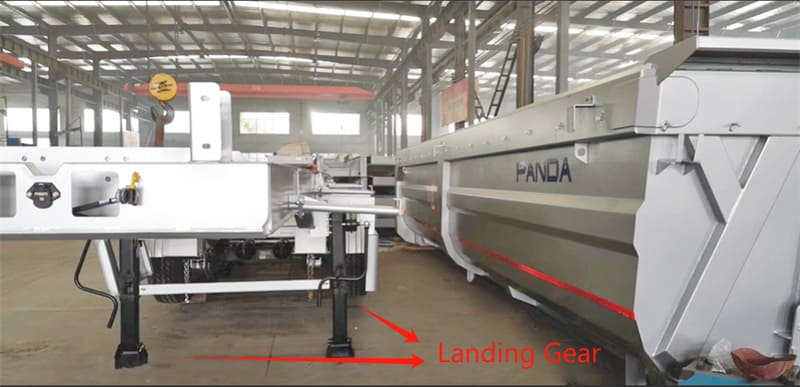
The king pin connects my trailer to the tractor head. It’s the part that locks into the fifth wheel so I can pull the trailer.
The landing gear is like the trailer’s legs. When I park and unhook the trailer, it holds up the front. I use it to raise or lower the trailer height too.
Other parts of semi tipper trailer
Electric system of semi tipper trailer
The end dump trailer electrical lighting system is a significant part of traffic safety at night, and its lighting system meets the demand of EEC standards. The system consists of sidelights, a reflector, and a 2*7 pin socket set.
Painting and the surface protection of semi tipper trailer
The frame must be sandblasted and surface hardened with a fully automatic strapping system. Then comes two times the construction of epoxy resin primers, and after the last two sprays, the rll code is baking at 60 and 80 degrees, making the whole surface more durable, better protected, and more beautiful.
Tarp
Some end dump semi trailers have tarps, depending on the cargo being transported, to protect the cargo from bad weather during transit.
Finally
Well, today our part of tipper semi trailer ends here. If you have any other questions, you are welcome to leave us a message at any time. We will usually reply you within 1 hour after receiving it.
Related:
Maybe you want
-
Coal Tipper Trailer For Sale
$25,500.00 -
Artic Bulk Tipper Trailer For Sale
$135,003.00

